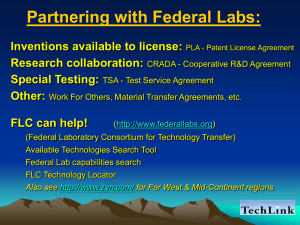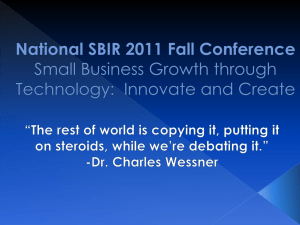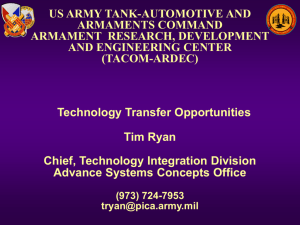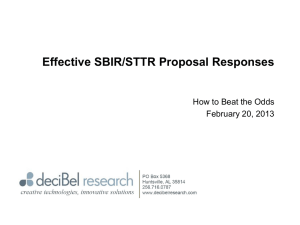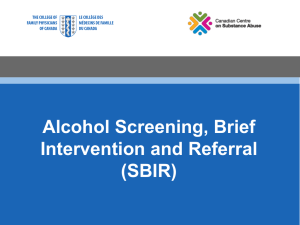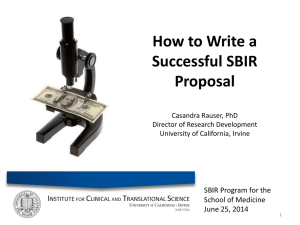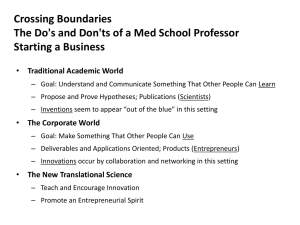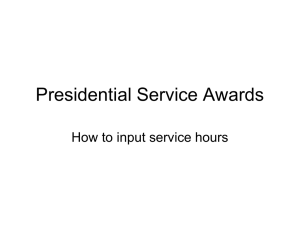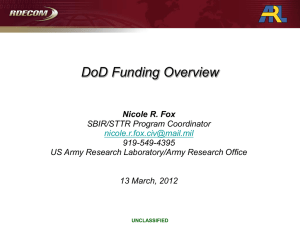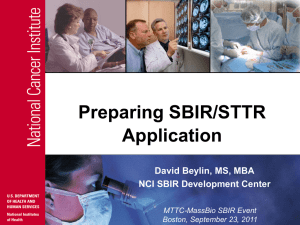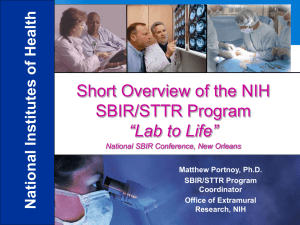Federal Labs and CRADAS: Tim Wittig, Principal, Technology
advertisement
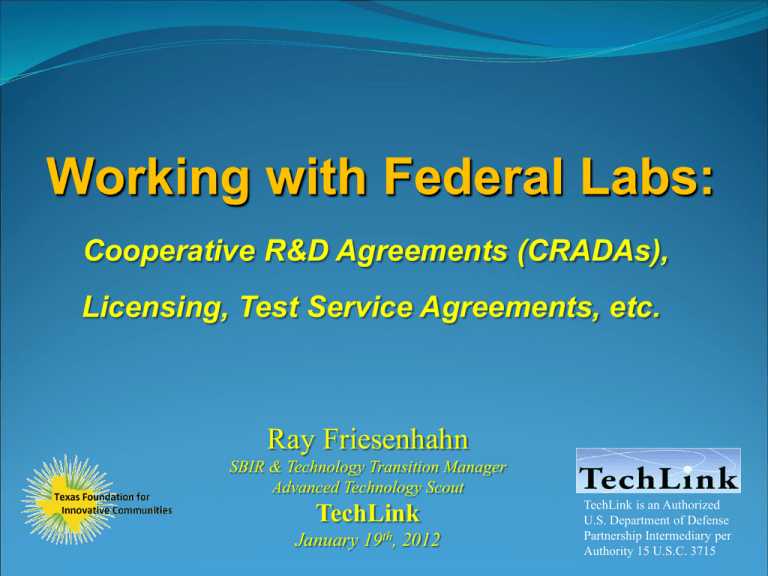
Working with Federal Labs: Cooperative R&D Agreements (CRADAs), Licensing, Test Service Agreements, etc. Ray Friesenhahn SBIR & Technology Transition Manager Advanced Technology Scout TechLink January 19th, 2012 TechLink is an Authorized U.S. Department of Defense Partnership Intermediary per Authority 15 U.S.C. 3715 Partnering for SBIR (& Business) Success o Few small businesses have all the skills and resources required to convince reviewers of their ability to innovate, develop viable new technology, and successfully commercialize it: o Research experience, lab facilities o Marketing skills o Manufacturing capabilities o Government accounting experience o Access to new, relevant markets (and servicing them) o The most successful firms are best at partnering! Partnering with Federal Labs: Advantages of a CRADA (Cooperative R&D Agreement): • Tie into significant R&D capability at little or no cost • Utilize specific R&D capability available nowhere else • Increase your perceived credibility based on partnership • Become familiar with Agency (customer) needs, culture • Agency personnel become familiar with your capabilities for potential advantage • Often opens doors for other funding opportunities • SBIR/STTR plus the OTHER 97% Leveraging Your Resources Technology Licensing Opportunities: • Technology already developed for DoD needs, dual-use • Available for small fraction of development cost • Can significantly enhance your own technology • Can increase your perceived credibility • Can build your connections with funding agencies • May even serve as basis for other funding opportunities CRADA: Infection Prevention Objective: To improve healing of wounded warfighters through the use of new antiinfective antibiofilm compounds. Benefits: Fewer wound infections and faster recovery, with reductions in mortality, hospitalization, and long-term impairment. Participants: • U.S. Army Institute of Surgical Research (USAISR) • ABC BioSciences Corp. • TechLink Status: • CRADA for Development of Military/Field Hospital Therapeutic Anti-infective, Antibiofilm Acute Wound Care Gel Product Technology: Company’s new BismuthThiol (BT) compounds disrupt the formation of bacterial biofilms and allow significantly improved wound treatment. Biofilm formation increases the antibiotic resistance of infectious bacteria, making treatment much more difficult. Bacterial biofilm growth in wounds (left) complicates medical treatment Company’s CRADA Results Research contract award from Orthopaedic Trauma Research Program (OTRP) $500K/year, for up to 5 years, some testing by USAISR Partnership in AFIRM Consortium Armed Forces Institute of Regenerative Medicine: two consortia will develop better treatments for seriously injured warfighters in $250 million program. Additional major funding opportunities being pursued. Key to DoD SBIR Success Build long-term relationships with appropriate DoD labs and organizations o Plan to be in for the long haul o Seek, build mutually beneficial relationships o CRADAs, Licenses, other Partnerships o Emphasize Service, Value to DoD and the Warfighter o Other funding opportunities may arise o Potential “slice of the pie,” vs. SBIR “seed money” o Plan for “Dual-Use” Success! SBIR Timeline & Client Example Timeline: SBIR to Commercialization “Perfect Match” SBIR topic posted Phase I Award Year 1 Company: Experienced, Competent, Capable, Focused, Aggressive Ideal Case: Phase II Award Year 2 Phase II Enhancement Year 3 Prime Contractor / Commercial Partner: Relevant Contract, Technical Need, Eager to Partner, Willing to work with small business Year 4 Initial Product Introduction (Software) Client Example: Visual Learning Systems, Inc. Transition Success: Feature AnalystTM Software Technology: Software for automated feature extraction in hyperspectral or panchromatic images. Learning algorithms are orders of magnitude faster than manual digitizing, also easy to train. • Developed under multiple SBIRs: • 3 NASA SBIR awards, 3 NSF • Army TEC Ph. I & II, NAVAIR Ph. I & II • CRADAs & Partnerships with Gov’t: • Army TEC & NUWC CRADAs • NASA TCA • NIMA & NRO partnerships • Partnered with Primes: • ESRI, Leica, BAE, Intergraph Chosen by NGA for deployment across all NGA’s Integrated Exploitation Capability (IEC) workstations – Now Dual-Use (Commercial & Military) Success! Timeline: Feature Analyst Transition NASA Stennis Phase II TCA with NASA JPL NASA Stennis Phase I NASA JPL Phase I NRO Fastmax NIMA “Big Ideas” Army TEC Phase I award NUWC CRADA Army TEC Phase II award Army TEC CRADA NIMA BAA NRL contract NSF Phase II NAVAIR Phase I award NAVAIR Phase II award Army TEC Phase I award Army TEC Phase II award Textron 1998 1999 2000 2001 2002 USFS Testing New Company: Visual Learning Systems Company: Integrated Geosciences ESRI partnership Feature Analyst for ArcGIS 2003 2004 2005 Overwatch Acquisition Acquisition $325M BAE Systems partnership FA for SOCET SET Leica Geosystems partnership FA for ERDAS NGA Product Adoption (Integrated Exploitation Capability) Client Example: Scientific Materials Corp. (SMC) Transition Success: Monoblock Laser (STORM) Technology: Manufacturing method for eye-safe rugged solid-state microlaser developed at Army CECOM under ManTech (2000 – 2001) • SMC used SBIR (30 awards, $7.5M) to develop world’s highest-quality laser & opto-electronic crystal growth processes (1992 – 2004) • License to SMC completed 2003 • TechLink/MilTech assisted with monoblock production improvement • Used in Small Tactical Optical Rifle Mounted (STORM) Micro-Laser Rangefinder (MLRF) • Thousands now deployed • SMC bought by FLIR for $13 M Leveraging SBIR/STTR to Partner with Federal Labs: • Since 2002, using SBIR funds for work at federal labs was prohibited, except with approval from SBA (considered only after selected for award) • Some individuals concerned about potential for conflicts of interest • Recent reauthorization now explicitly allows funding of work at federal labs, including CRADAs, Test Service Agreements, Work for Others, etc. • Agencies cannot condition an SBIR/STTR award upon entering into an agreement with a federal lab Note: federal labs cannot provide funding to a company under a CRADA SEC. 5109. COLLABORATING WITH FEDERAL LABORATORIES AND RESEARCH AND DEVELOPMENT CENTERS. Section 9 of the Small Business Act (15 U.S.C. 638), as amended by this title, is further amended by adding at the end the following: ‘‘(ee) COLLABORATING WITH FEDERAL LABORATORIES AND RESEARCH AND DEVELOPMENT CENTERS.— ‘‘(1) AUTHORIZATION.—Subject to the limitations under this section, the head of each participating Federal agency may make SBIR and STTR awards to any eligible small business concern that— ‘‘(A) intends to enter into an agreement with a Federal laboratory or federally funded research and development center for portions of the activities to be performed under that award; or ‘‘(B) has entered into a cooperative research and development agreement (as defined in section 12(d) of the StevensonWydler Technology Innovation Act of 1980 (15 U.S.C.10 3710a(d))) with a Federal laboratory. ‘‘(2) PROHIBITION.—No Federal agency shall— ‘‘(A) condition an SBIR or STTR award upon entering into agreement with any Federal laboratory or any federally funded laboratory or research and development center for any portion of the activities to be performed under that award; ‘‘(B) approve an agreement between a small business concern receiving an SBIR or STTR award and a Federal laboratory or federally funded laboratory or research and development center, if the small business concern performs a lesser portion of the activities to be performed under that award than required by this section and by the SBIR Policy Directive and the STTR Policy Directive of the Administrator; or ‘‘(C) approve an agreement that violates any provision, including any data rights protections provision, of this section or the SBIR and the STTR Policy Directives. ‘‘(3) IMPLEMENTATION.—Not later than 180 days after the date of enactment of this subsection, the Administrator shall modify the SBIR Policy Directive and the STTR Policy Directive issued under this section to ensure that small business concerns— ‘‘(A) have the flexibility to use the resources of the Federal laboratories or federally funded research and development centers; and ‘‘(B) are not mandated to enter into agreement with any Federal laboratory or any federally funded laboratory or research and development center as a condition of an award. ‘‘(4) ADVANCE PAYMENT.—If a small business concern receiving an award under this section enters into an agreement with a Federal laboratory or federally funded research and development center for portions of the activities to be performed under that award, the Federal laboratory or federally funded research and development center may not require advance payment from the small business concern in an amount greater than the amount necessary to pay for 30 days of such activities.’’.
